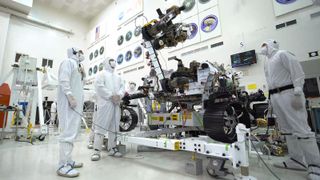Feel the Burn! Watch NASA's 2020 Mars Rover Do a Bicep Curl (Video)
Can you curl 88 lbs.?
In a minidisplay of robot Olympian power, NASA's next Mars rover easily bicep-curled 88 lbs. (40 kilograms) in a California clean room.
A new video shows the Mars 2020 rover flexing its joints as huddling technicians at NASA's Jet Propulsion Laboratory (JPL) supervise the spacecraft's every move. The rover was moving around a hefty turret that includes HD cameras, a percussive drill, a coring mechanism and other instruments to examine the composition of Mars rocks.
"This was our first opportunity to watch the arm and turret move in concert with each other, making sure that everything worked as advertised — nothing blocking or otherwise hindering smooth operation of the system," said Dave Levine, integration engineer for Mars 2020, in a JPL statement.
Related: NASA's Mars Rover 2020 Mission in Pictures (Gallery)
"Standing there, watching the arm and turret go through their motions, you can't help but marvel that the rover will be in space in less than a year from now and performing these exact movements on Mars in less than two," Levine added.

The rover is scheduled to launch from Cape Canaveral Air Force Station in Florida in July 2020 and land inside Mars' Jezero Crater on Feb. 18, 2021.
Once there, Mars 2020 will characterize the geology of the area, which hosted a river delta in the ancient past, and search for signs of long-dead life.
Get the Space.com Newsletter
Breaking space news, the latest updates on rocket launches, skywatching events and more!
The six-wheeled robot will also cache the most-promising samples, for possible return to Earth in the coming years. Mars 2020 has a suite of powerful instruments, but labs here on Earth have much more capable and diverse science gear, the kind of advanced equipment that might be necessary to spot a Martian biosignature in ancient rocks.
Mars 2020's observations will also help NASA prepare for human exploration on the Red Planet in future decades, agency officials have said. NASA is working to land humans on the moon by 2024, to help prepare for crewed missions to Mars in the 2030s.
- 4 Mars Missions Are One Year Away from Launching to the Red Planet in July 2020
- NASA's 2020 Mars Rover Gets Its 1st Wheels, and a Mast, Too (Ahoy!)
- You Can Watch NASA's Build Its Mars 2020 Rover Live Online
Follow Elizabeth Howell on Twitter @howellspace. Follow us on Twitter @Spacedotcom and on Facebook.
Join our Space Forums to keep talking space on the latest missions, night sky and more! And if you have a news tip, correction or comment, let us know at: community@space.com.

Elizabeth Howell (she/her), Ph.D., is a staff writer in the spaceflight channel since 2022 covering diversity, education and gaming as well. She was contributing writer for Space.com for 10 years before joining full-time. Elizabeth's reporting includes multiple exclusives with the White House and Office of the Vice-President of the United States, an exclusive conversation with aspiring space tourist (and NSYNC bassist) Lance Bass, speaking several times with the International Space Station, witnessing five human spaceflight launches on two continents, flying parabolic, working inside a spacesuit, and participating in a simulated Mars mission. Her latest book, "Why Am I Taller?", is co-written with astronaut Dave Williams. Elizabeth holds a Ph.D. and M.Sc. in Space Studies from the University of North Dakota, a Bachelor of Journalism from Canada's Carleton University and a Bachelor of History from Canada's Athabasca University. Elizabeth is also a post-secondary instructor in communications and science at several institutions since 2015; her experience includes developing and teaching an astronomy course at Canada's Algonquin College (with Indigenous content as well) to more than 1,000 students since 2020. Elizabeth first got interested in space after watching the movie Apollo 13 in 1996, and still wants to be an astronaut someday. Mastodon: https://qoto.org/@howellspace
Most Popular

